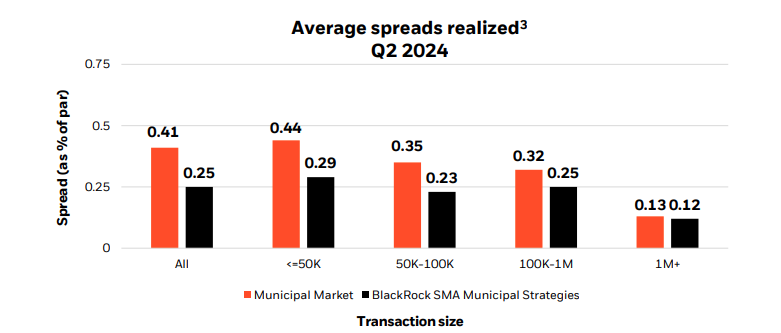BlackRock’s fixed income SMAs
Explore BlackRock’s full platform of fixed income SMAs to address your clients’ needs.
Advance Static Table-1,Paragraph-1
Advance Static Table-2,Paragraph-2
| Fixed Income Strategy | Avg. yield to worst (%) | Avg. coupon (%) | Avg. effective duration (yrs) | Fact Sheet | Sample Portfolio | GIPS Composite Report |
|---|---|---|---|---|---|---|
| Short-Term Municipal | 2.82 | 5.00 | 2.87 | Fact Sheet | Sample Portfolio | GIPS Composite Report |
| Intermediate Municipal | 3.02 | 5.00 | 4.75 | Fact Sheet | Sample Portfolio | GIPS Composite Report |
| Long-Term Municipal | 3.44 | 4.93 | 7.96 | Fact Sheet | Sample Portfolio | GIPS Composite Report |
| Municipal Opportunities† | 3.70 | 4.93 | 4.96 | Fact Sheet | Sample Portfolio | GIPS Composite Report |
| Municipal Ladder 1-5 year | 2.86 | 5.00 | 2.43 | Fact Sheet | Sample Portfolio | GIPS Composite Report |
| Municipal Ladder 1-10 year | 2.95 | 5.00 | 4.22 | Fact Sheet | Sample Portfolio | GIPS Composite Report |
| Municipal Ladder 5-15 year | 3.17 | 5.00 | 6.22 | Fact Sheet | Sample Portfolio | GIPS Composite Report |
| Municipal Ladder 10-20 year | 3.48 | 5.00 | 7.11 | Fact Sheet | Sample Portfolio | GIPS Composite Report |
*For illustrative purposes only. Past performance is not indicative of future results. Portfolio characteristic data is pulled from the respective sample portfolio. The portfolio characteristics shown are the
data points most requested by Financial Advisor clients. Please click on the sample portfolio link for more information. Data as of November 1, 2024.
† BlackRock Allocation Target Shares (BATS) mutual funds available for use within BlackRock Separately Managed Account Strategies
| Fixed Income Strategy | Avg. yield to worst (%) | Avg. coupon (%) | Avg. effective duration (yrs) | Fact Sheet | Sample Portfolio | GIPS Composite Report |
|---|---|---|---|---|---|---|
| Short-Term Taxable | 4.39 | 4.15 | 1.86 | Fact Sheet | Sample Portfolio | GIPS Composite Report |
| Intermediate Taxable | 4.68 | 3.34 | 4.30 | Fact Sheet | Sample Portfolio | GIPS Composite Report |
| Fundamental Core Taxable | 4.75 | 3.43 | 5.95 | Fact Sheet | Sample Portfolio | GIPS Composite Report |
| Short Duration† | 4.27 | 3.89 | 1.86 | Fact Sheet | Sample Portfolio | GIPS Composite Report |
| Core Bond† | 4.54 | 3.63 | 5.85 | Fact Sheet | Sample Portfolio | GIPS Composite Report |
| Government/Corporate Taxable | 4.51 | 3.21 | 6.15 | Fact Sheet | Sample Portfolio | GIPS Composite Report |
| Corporate Ladder 1-5 year | 4.76 | 4.04 | 2.27 | Fact Sheet | Sample Portfolio | GIPS Composite Report |
| Corporate Ladder 1-10 year | 4.89 | 4.10 | 4.39 | Fact Sheet | Sample Portfolio | GIPS Composite Report |
*For illustrative purposes only. Past performance is not indicative of future results. Portfolio characteristic data is pulled from the respective sample portfolio. The portfolio characteristics shown are the
data points most requested by Financial Advisor clients. Please click on the sample portfolio link for more information. Data as of November 1, 2024.
† BlackRock Allocation Target Shares (BATS) mutual funds available for use within BlackRock Separately Managed Account Strategies
Subscribe to monthly updates on portfolio characteristics
Sign up to receive a monthly email when the portfolio characteristics for our suite of municipal and taxable fixed income SMA strategies are updated.
Please try again
A discussion on fixed income SMAs: Hear from the experts
Kevin Staub, SMA Commercial Strategy and Duane Liedl, Senior Portfolio Manager discuss fixed income SMAs and how BlackRock is partnering with advisors to help deliver personalized solutions to their clients.
Why SMAs for fixed income investors?
A fixed income SMA is a portfolio of individual bonds that blends the benefits of direct ownership and institutional asset management. The unique structure of an SMA can provide benefits to both advisors and their clients.
Why BlackRock for fixed income SMAS
BlackRock is a leader in the fixed income SMA industry, managing over $70B in client assets.1 Our platform offers a scalable process to help advisors build personalized bond portfolios for their clients.
Scale matters when trading municipal bonds
BlackRock generally trades on the financial market to purchase bonds for clients at a larger scale, potentially benefiting investors with lower transaction costs and greater access to inventory.

BlackRock customizes fixed income SMAs across five dimensions
BlackRock fixed income SMAs offer a range of enhanced customization capabilities seeking to deliver personalized solutions for advisors and their clients.

FAQ's
-
Not all bonds are created equal. Some of the key differences between municipal and taxable bonds include the issuer and type of projects that will be funded, risk profile, yields and tax implications. It is important to consider the potential benefits and risks of each when deciding the best option for your specific situation.
-
Taxes vary according to the type of bond you own. Tax-equivalent yield is the return calculation that puts a taxable and tax-exempt bond on equal footing. To calculate tax-equivalent yield, divide the municipal (tax-free) yield by 100% minus the investor’s tax bracket. This formula helps in comparing municipal and taxable bonds.
-
Bonds typically pay interest on a semiannual basis, or every 6-months.
- All
- Bonds / Fixed Income
-
![Active management will drive muni returns in 2024]() Bonds / Fixed Income
Bonds / Fixed IncomeActive management will drive muni returns in 2024
Dec 6, 2024 | By BlackRockMarket update from BlackRock's municipal bond team. -
![Monthly commentary: Strategic Income Opportunities Fund]() Bonds / Fixed Income
Bonds / Fixed IncomeMonthly commentary: Strategic Income Opportunities Fund
Nov 27, 2024 | By BlackRockThe portfolio managers of the BlackRock Strategic Income Opportunities Fund discuss the fund’s performance and positioning in this monthly commentary. -
![Monthly commentary: Total Return Fund]() Bonds / Fixed Income
Bonds / Fixed IncomeMonthly commentary: Total Return Fund
Nov 27, 2024 | By BlackRockA diversified core bond strategy can help your portfolio deliver more consistent performance through market cycles. BlackRock Total Return Fund seeks returns in a variety of fixed income sectors while providing protection when stocks fall. -
![There’s Still Time to Reduce Tax Drag]() Tax
TaxThere’s Still Time to Reduce Tax Drag
Nov 18, 2024 | By Daniel Prince, CFALearn about two common ways to reduce portfolio tax costs as we approach year-end: tax loss harvesting and avoiding capital gains distributions. -
![Tax loss harvesting with bond ETFs]() Tax
TaxTax loss harvesting with bond ETFs
Nov 8, 2024 | By Karen Veraa-Perry, CFALearn about the opportunities to tax-loss harvest bond funds to lower clients’ tax bills. -
![iBonds ETFs: What to do with maturing iBonds?]() Bonds / Fixed Income
Bonds / Fixed IncomeiBonds ETFs: What to do with maturing iBonds?
Nov 8, 2024 | By Karen Veraa, CFAWith 2024 iBonds ETFs maturing in late 2024, read our latest insight to learn a few ways to keep your clients invested and on track with their investment goals. -
![Investing Around the Election and the Government Debt Problem]() Multi-Asset
Multi-AssetInvesting Around the Election and the Government Debt Problem
Rick Rieder explains how the US economy is resilient, the government debt issue and how to invest in stocks and bonds in the months around the election. -
![Moving the Needle]() Multi-Asset
Multi-AssetMoving the Needle
Market Insight: Moving the Needle Rick Rieder and team outline an evolution of portfolio construction for the current environment. -
![The Fed has started cutting interest rates. Now what?]() Bonds / Fixed Income
Bonds / Fixed IncomeThe Fed has started cutting interest rates. Now what?
With the Fed decision to cut rates, we explore how markets have historically reacted in cutting cycles and where we see the most opportunity in today's market. -
![Abundant Income]() Multi-Asset
Multi-AssetAbundant Income
Rick Rieder and team argue that the economy is making further progress towards normalization and continues to offer a once-in-a-generation investing opportunity. -
![Seek higher yields with iBonds ETFs or Bond SMAs]() Bonds / Fixed Income
Bonds / Fixed IncomeSeek higher yields with iBonds ETFs or Bond SMAs
May 21, 2024 | By Karen Veraa, CFABond ladders can be a great way to enjoy steadier income until maturity. Lock in rates now with BlackRock’s bond laddering strategies. -
![Rotation to Duration: Seeking a More Resilient Portfolio]() Bonds / Fixed Income
Bonds / Fixed IncomeRotation to Duration: Seeking a More Resilient Portfolio
Apr 29, 2024 | By BlackRockConsider adding duration to your investment portfolio. A potential Fed pause creates an opportunity, and duration can offer protection from market volatility -
![No time to yield: Getting your clients into bonds]() Bonds / Fixed Income
Bonds / Fixed IncomeNo time to yield: Getting your clients into bonds
Apr 25, 2024 | By Karen Veraa, CFADiscover how bond ETFs can be a powerful investment tool for advisors to help clients get their cash off the sidelines and capture today’s elevated yields. -
![Taking Stock of (and in) Markets with Rick Rieder]() Bonds / Fixed Income
Bonds / Fixed IncomeTaking Stock of (and in) Markets with Rick Rieder
Rick Rieder discusses that as the economy appears to be returning to more normal conditions, advisors and their clients must evolve their portfolio construction. -
![Rieder- The Fixed Income Opportunity for 2024]() Bonds / Fixed Income
Bonds / Fixed IncomeRieder- The Fixed Income Opportunity for 2024
Rick Rieder argues that fixed income asset returns can appear prospectively most attractive after a prolonged back up in rates, so we see compelling opportunity.



























